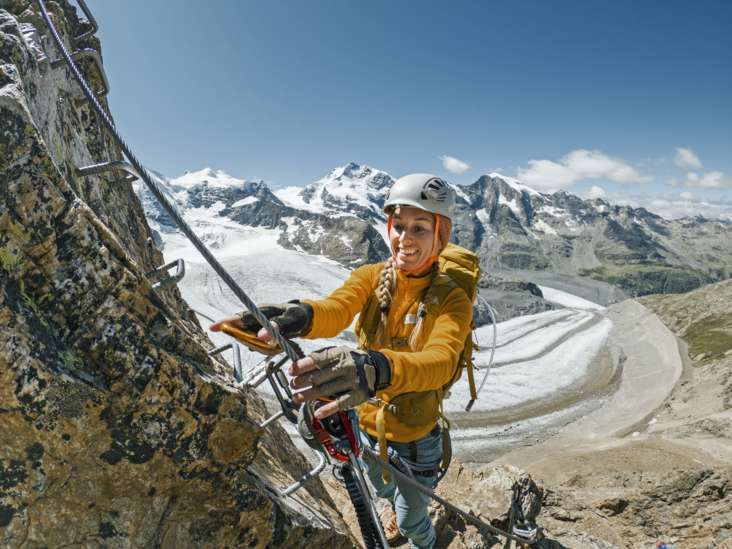Anyone who ventures on a via ferrata tour should be surefooted and have a head for heights. The fact that you can access an exposed rock face even without special climbing skills is thanks to a solid steel cable that runs up and along the rock face through fixed anchors. A via ferrata – which literally means “iron path” in Italian – is equipped with handholds and rungs, ladders and suspension bridges. In this way, even people without climbing experience can master steep rock faces and exposed traverses, always secured on the continuous steel rope.
Only with suitable equipment
The right equipment is essential for climbing a via ferrata: sturdy hiking boots, a helmet, a climbing harness and the so-called via ferrata set. This comprises a lanyard with two carabiners and a shock absorber, and connects the climbing harness to the steel rope of the via ferrata. The basic technique for moving forward is as follows: with the two carabiners, you clip yourself to the steel cable and push the via ferrata set along with your hand while you clamber up the rock face. When you come to a metal anchor, you need to unhook one carabiner and re-hook it above the anchor – one at a time, so that you always remain firmly attached.
Careful planning is a must
Tours on via ferratas require a high degree of self-responsibility, the ability to assess one’s own capabilities, and a keen awareness of potential dangers. Thorough preparation and careful planning help to prevent emergencies. The Swiss Alpine Club SAC has compiled ten useful tips for climbing a via ferrata safely, which can be found on its website.
When choosing a via ferrata, it is important to inform yourself about the different difficulty levels and adapt the route to your ability. Do not overestimate yourself and if in doubt, opt for a slightly easier tour. Take into account not only the difficulty rating, but also other criteria, such as differences in altitude, exposure to the elements, the time it takes to reach and climb the via ferrata, as well as the weather conditions. On a via ferrata, turning back is difficult or sometimes even impossible.
Not without its risks
Even though via ferratas provide a relatively easy introduction to climbing, they are not without danger. In contrast to sport climbing, which also involves falling into the rope, on a via ferrata the aim is to avoid a fall wherever possible. Although you are secured by the via ferrata set – in the event of a fall, the shock absorber in the via ferrata set tears opens and dampens the force of the fall somewhat – it is still possible to injure yourself.
According to the Swiss Council for Accident Prevention (bfu), accidents with fatal consequences usually happen because of belaying mistakes. Reasons for this are tiredness and lack of concentration. Therefore, you should also make sure that you eat and drink enough and take regular breaks to keep up your strength and remain focused.
Tip from the Operations Centre
If an emergency situation or accident does occur, Rega is always there for you. We recommend that you raise the alarm using the Rega emergency app. The app transmits your coordinates to the Rega Operations Centre and sets up a telephone connection with a flight coordinator. They decide which means of rescue is most suitable and whether the SAC mountain rescuers need to be called out to assist the helicopter crew in the difficult terrain.
In the event of an emergency, the following information is useful for our flight coordinators: the section of the via ferrata you are on; whether or not you have a firm foothold; if there is a rock overhang above you; the colour of your clothing. Then, when the Rega helicopter appears in the sky, you can help the helicopter crew by drawing attention to yourself with the correct signal: stretch your arms up in the air to form a Y. This stands for “yes”, I need help.

